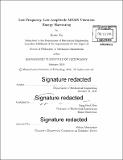Low-frequency, low-amplitude MEMS vibration energy harvesting
Author(s)
Xu, Ruize, Ph. D. Massachusetts Institute of Technology
DownloadFull printable version (25.65Mb)
Alternative title
Low-frequency, low-amplitude micro electro mechanical systems vibration energy harvesting
Other Contributors
Massachusetts Institute of Technology. Department of Mechanical Engineering.
Advisor
Sang-Gook Kim.
Terms of use
Metadata
Show full item recordAbstract
Vibration energy harvesters work effectively only when the operating conditions match with the available vibration source. Typical resonating MEMS structures cannot be used with low-frequency, low-amplitude and unpredictable nature of ambient vibrations. Bi-stable nonlinear oscillator based energy harvesters are developed for lowering the operating frequency while widening the bandwidth, and are realized at MEMS scale for the first time. This design concept does not rely on the resonance of the MEMS structure but operates with the large snapping motion of the beam at very low frequencies when proper conditions are provided to overcome the energy barrier between the two energy wells of the structure. A fully functional piezoelectric MEMS energy harvester is designed, monolithically fabricated and tested. An electromechanical lumped parameter model is developed to analyze the nonlinear dynamics and to guide the design of the multi-layer buckled beam structure. Residual stress induced buckling is achieved through the progressive control of the deposition along the fabrication steps. Static surface profile of the released device shows bi-stable buckling of 200 [mu]m which matches very well with the design. Dynamic testing demonstrates the energy harvester operates with 35% bandwidth under 70Hz at 0.5g, operating conditions that have not been met before by MEMS vibration energy harvesters.
Description
Thesis: Ph. D., Massachusetts Institute of Technology, Department of Mechanical Engineering, 2018. Cataloged from PDF version of thesis. Includes bibliographical references (pages 187-195).
Date issued
2018Department
Massachusetts Institute of Technology. Department of Mechanical EngineeringPublisher
Massachusetts Institute of Technology
Keywords
Mechanical Engineering.